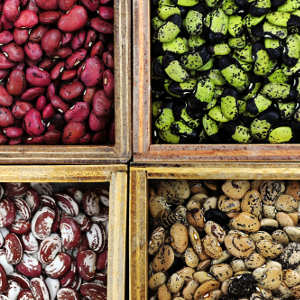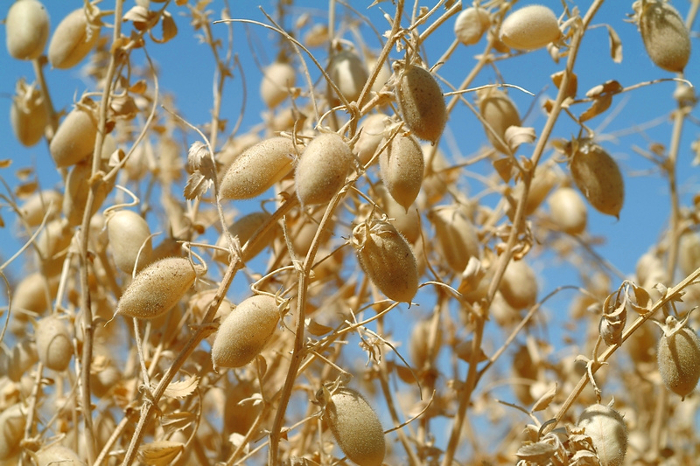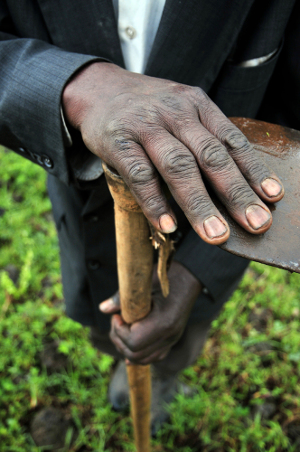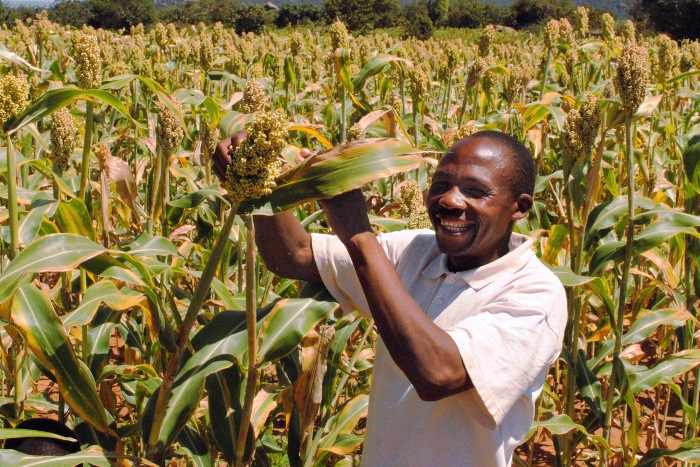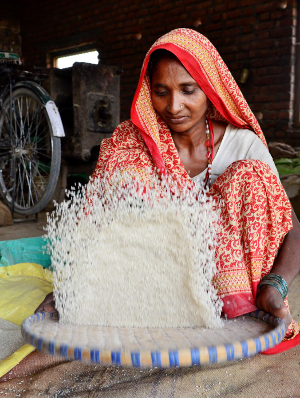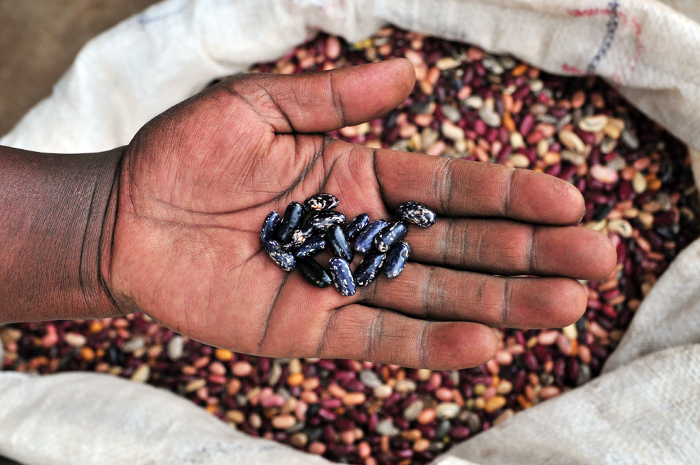“In the last 10 years we have had a revolution in terms of developing the genetic resources of crops.”
So says Pooran Gaur, Principal Scientist for chickpea genetics and breeding at the International Crops Research Institute for the Semi-Arid Tropics (ICRISAT), and Product Delivery Coordinator for chickpeas for the CGIAR Generation Challenge Programme (GCP).
He attributes this revolution in large part to GCP, saying it “played the role of catalyst. It got things started. It set the foundation. Now we are in a position to do further molecular breeding in chickpeas.”
Led by Pooran, researchers from India, Ethiopia and Kenya worked together not only to develop improved, drought-tolerant chickpeas that would thrive in semiarid conditions, but also to ensure these varieties would be growing in farmers’ fields across Africa within a decade.
The 10-year Generation Challenge Programme, with the goal of improving food security in developing countries, aimed to leave plant genetic assets as an important part of its legacy.
Diagnostic, or informative, molecular markers – which act like ‘tags’ for beneficial genes scientists are looking for – are an increasingly important genetic tool for breeders in developing resilient, improved varieties, and have been a key aspect of GCP’s research.
What is a diagnostic molecular marker?
Developments in plant genetics over the past 10–15 years have provided breeders with powerful tools to detect beneficial traits of plants much more quickly than ever before.
Scientists can identify individual genes and explore which ones are responsible for, or contribute to, valuable characteristics such as tolerance to drought or poor soils, or resistance to pests or diseases.
Once a favourable gene for a target agronomic trait is discovered and located in the plant’s genome, the next step is to find a molecular marker that will effectively tag it. A molecular marker is simply a variation in the plant’s DNA sequence that can be detected by scientists using any of a range of methods. When one of these genetic variants is found close on the genome to a gene of interest (or even within the gene itself), it can be used to indicate the gene’s presence.
To use an analogy, think of a story as the plant’s genome: its words are the plant’s genes, and a molecular marker works like a text highlighter. Molecular markers are not precise enough to highlight specific words (genes), but they can highlight sentences (genomic regions) that contain these words, making it easier and quicker to identify whether or not they are present.
Once a marker is found to be associated with a gene, or multiple genes, and determined to be significant to a target trait, it is designated an informative marker, diagnostic marker or predictive marker. Some simple traits such as flower colour are controlled by one gene, but more complex traits such as drought tolerance are controlled by multiple genes. Diagnostic markers enable plant breeders to practise molecular breeding.
Breeders use markers to predict plant traits
In the process known as marker-assisted selection, plant breeders use diagnostic molecular markers early in the breeding process to determine whether plants they are developing will have the desired qualities. By testing only a small amount of seed or seedling tissue, breeders are able to choose the best parent plants for crossing, and easily see which of the progeny have inherited useful genes. This considerably shortens the time it takes to develop new crop varieties.
“We use diagnostic markers to check for favourable genes in plants under selection. If the genes are present, we grow the seed or plant and observe how the genes are expressed as plant characteristics in the field [phenotyping]; if the genes are not present, we throw the seed or plant away,” explains Steve Beebe, a leading bean breeder with the International Center for Tropical Agriculture (CIAT) and GCP’s Product Delivery Coordinator for beans.
“This saves us resources and time, as instead of a growing few thousand plants to maturity, most of which would not possess the gene, by using markers to make our selection we need to grow and phenotype only a few hundred plants which we know have the desired genes.”
GCP supported 25 projects to discover and develop markers for genes that control traits that enable key crops, including bean and chickpea, to tolerate drought and poor soils and resist pests and diseases.
Genomic resources, including genetic maps and genotyping datasets, were developed during GCP’s first phase (2004–2008) and were then used in molecular-breeding projects during the second five years of the Programme (2009–2014).
“GCP’s philosophy was that we have, in breeding programmes, genomic resources that can be utilised. Now we are well placed, and we should be able to continue even after GCP with our molecular-breeding programme,” says Pooran.
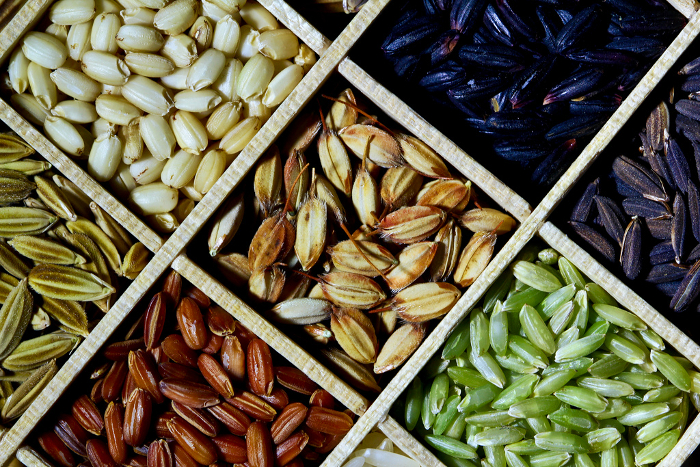
A small selection of the rice diversity in the International Rice Research Institute gene bank – raw material for the creation of genomic resources.
Markers developed for drought tolerance
With climate change making droughts more frequent and severe, breeding for drought tolerance was a key priority for GCP from its inception.
Different plants may use similar strategies to tolerate drought, for example, having longer roots or reducing water loss from leaves. But drought tolerance is a complex trait to breed, as in each crop a large number of genes are involved.
Wheat, for example, has many traits – each controlled by different genes – that allow the crop to tolerate extreme temperature and/or lack of moisture. Identifying drought tolerance in wheat is therefore a search for many genes. In the particular case of wheat, this search is compounded by its genetic make-up, which is one of the most complex in the plant kingdom.
The difficulty of identifying genes that play a significant role in drought tolerance makes it all the more impressive when researchers successfully collaborate to overcome these challenges. GCP-supported scientists were able to develop and use diagnostic markers in chickpea, rice, sorghum and wheat to breed for drought tolerance. The first new drought-tolerant varieties bred using marker-assisted selection have already been released to farmers in Africa and Asia and are making significant contributions to food and income security.
Markers developed for pests and diseases
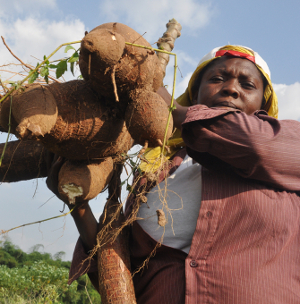
A bumper harvest of cassava roots at the International Institute of Tropical Agriculture (IITA) in Nigeria.
Cassava mosaic disease (CMD) is the biggest threat to cassava production in Africa – where more cassava is grown and eaten than any other crop. A principal source of CMD resistance is CMD2, a dominant gene that confers high levels of resistance.
Nigerian GCP-supported researchers worked on identifying and validating diagnostic markers that are associated with CMD2. These markers are being used in marker-assisted selection work to transfer CMD resistance to locally-adapted, farmer-preferred varieties.
In the common bean, GCP-supported researchers identified genes for resistance to pests such as bean stem maggot in Ethiopia, as well as diseases such as the common mosaic necrosis potyvirus and common bacterial blight, which reduce bean quality and yields and in some cases means total crop losses.
Markers developed for acidic and saline soils
Aluminium toxicity and phosphorus deficiency, caused by imbalanced nutrient availability in acid soils, are major factors in inhibiting crop productivity throughout the world. Aluminium toxicity also exacerbates the effects of drought by inhibiting root growth.
Diagnostic markers for genes that confer tolerance to high levels of aluminium and improve phosphorus uptake were identified in sorghum, maize and rice. The markers linked to these two sets of similar major genes have been used efficiently in breeding programmes in Africa and Asia.
Salt stress is also a major constraint across many rice-producing areas, partly because modern rice varieties are highly sensitive to salinity. Farmers in salt-affected areas have therefore continued growing their traditional crop varieties, which are more resilient but give low yields with poor grain quality. To address this issue, GCP supported work to develop and use markers to develop popular Bangladeshi varieties with higher tolerance to salt. GCP also funded several PhD students working in this area, one of whom was Armin Bhuiya.
Markers mean information, which means power
Diagnostic molecular markers are, in their most essential form, data. That means they are easily stored and maintained as data in publicly accessible databases and publications. Breeders can now access the molecular markers developed for various crops through the Integrated Breeding Platform – a web-based one-stop shop for integrated breeding information (including genetic resources), tools and support, which was established by GCP and is now continuing independently following GCP’s close – in order to design and carry out breeding projects.
“We could not have done that much in developing genomic resources without GCP support,” says Pooran. “Now the breeding products are coming; the markers are strengthening our work; and you will see in the next five to six years more products coming from molecular breeding.
“For me, GCP has improved the efficiency of the breeding programme – that is the biggest advantage.”
More links
- Here on the Sunset Blog: chickpea | bean | cassava | maize | rice | sorghum | wheat | comparative genomics
- Diagnostic molecular markers available on the IBP website








